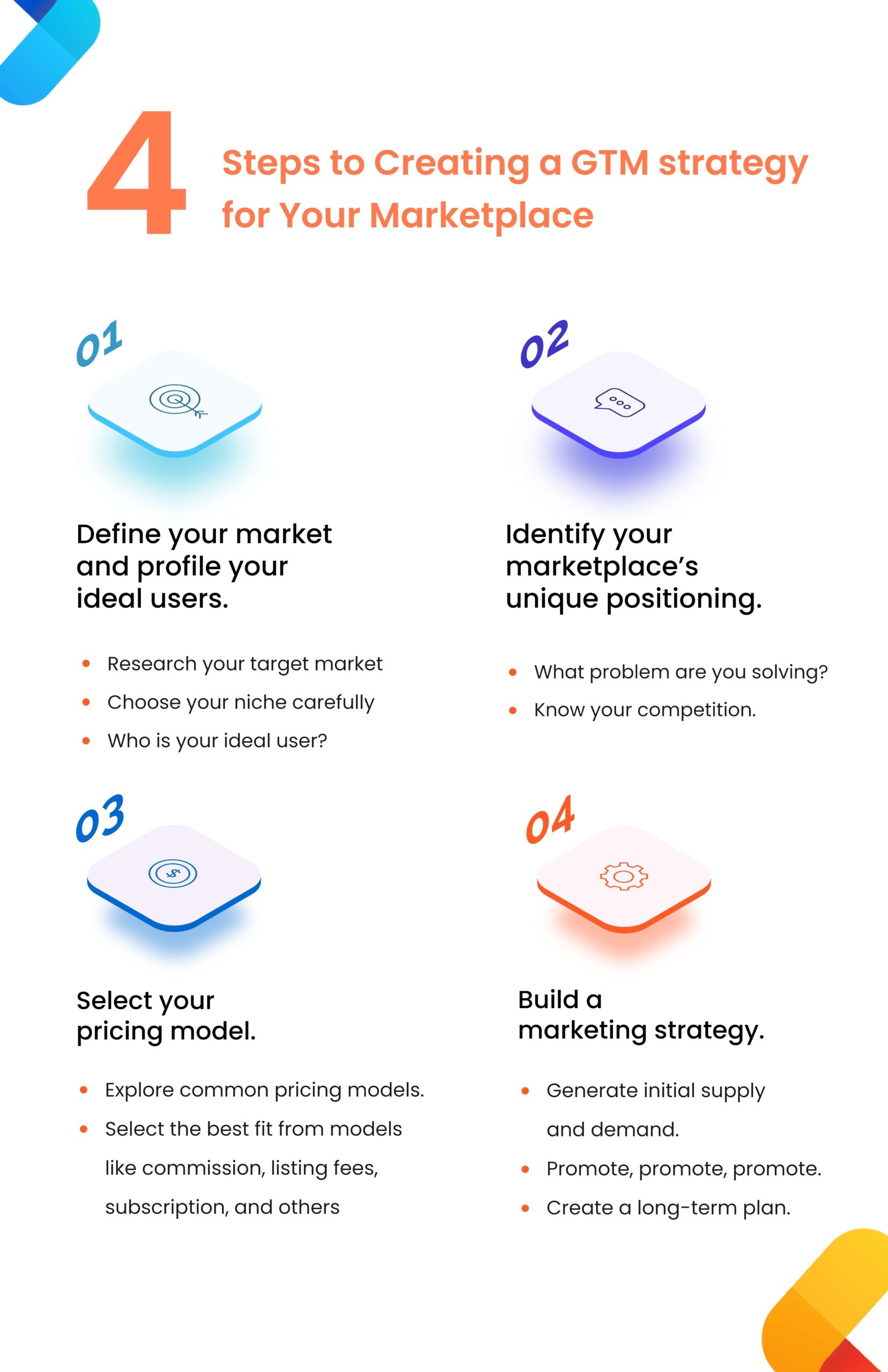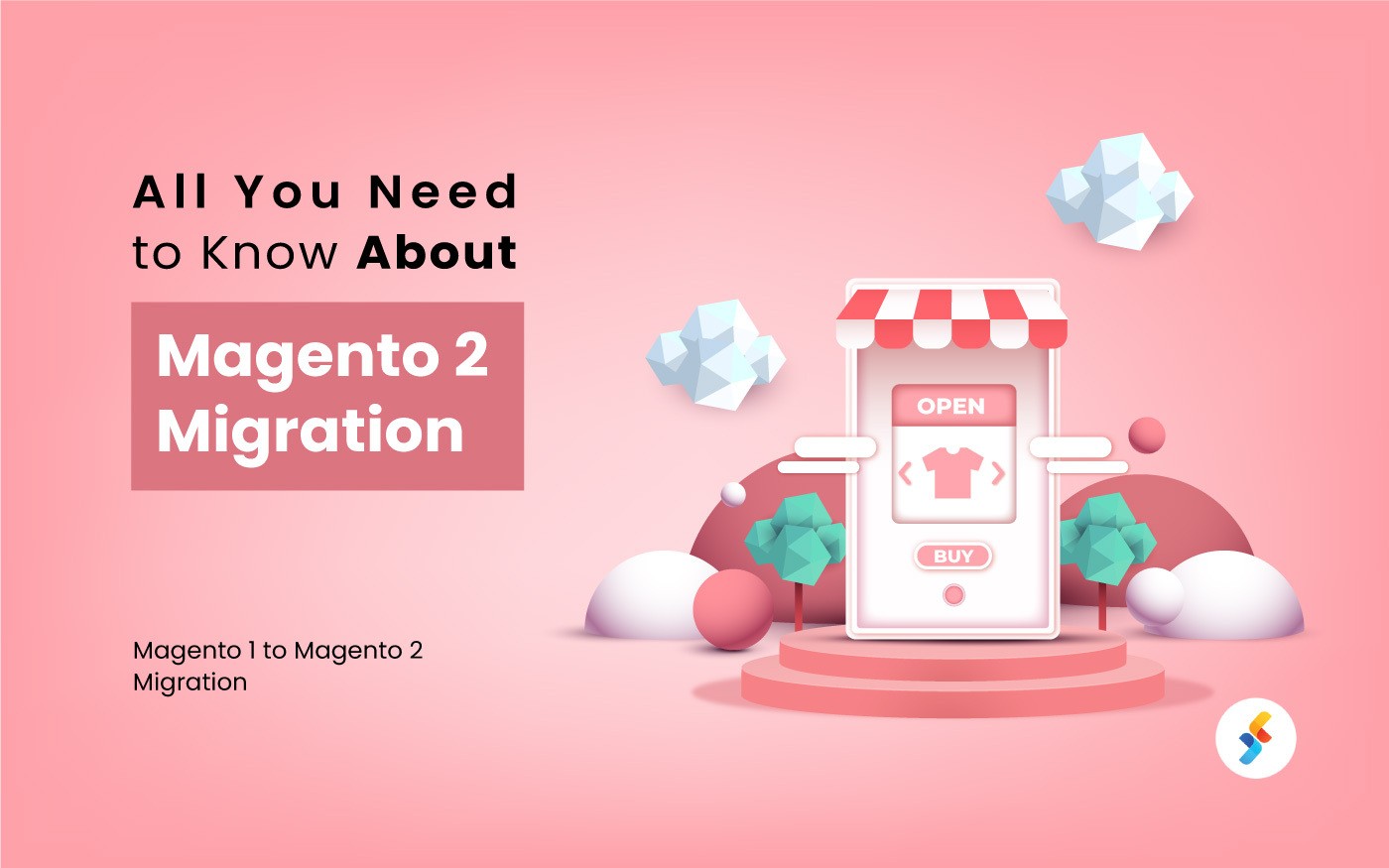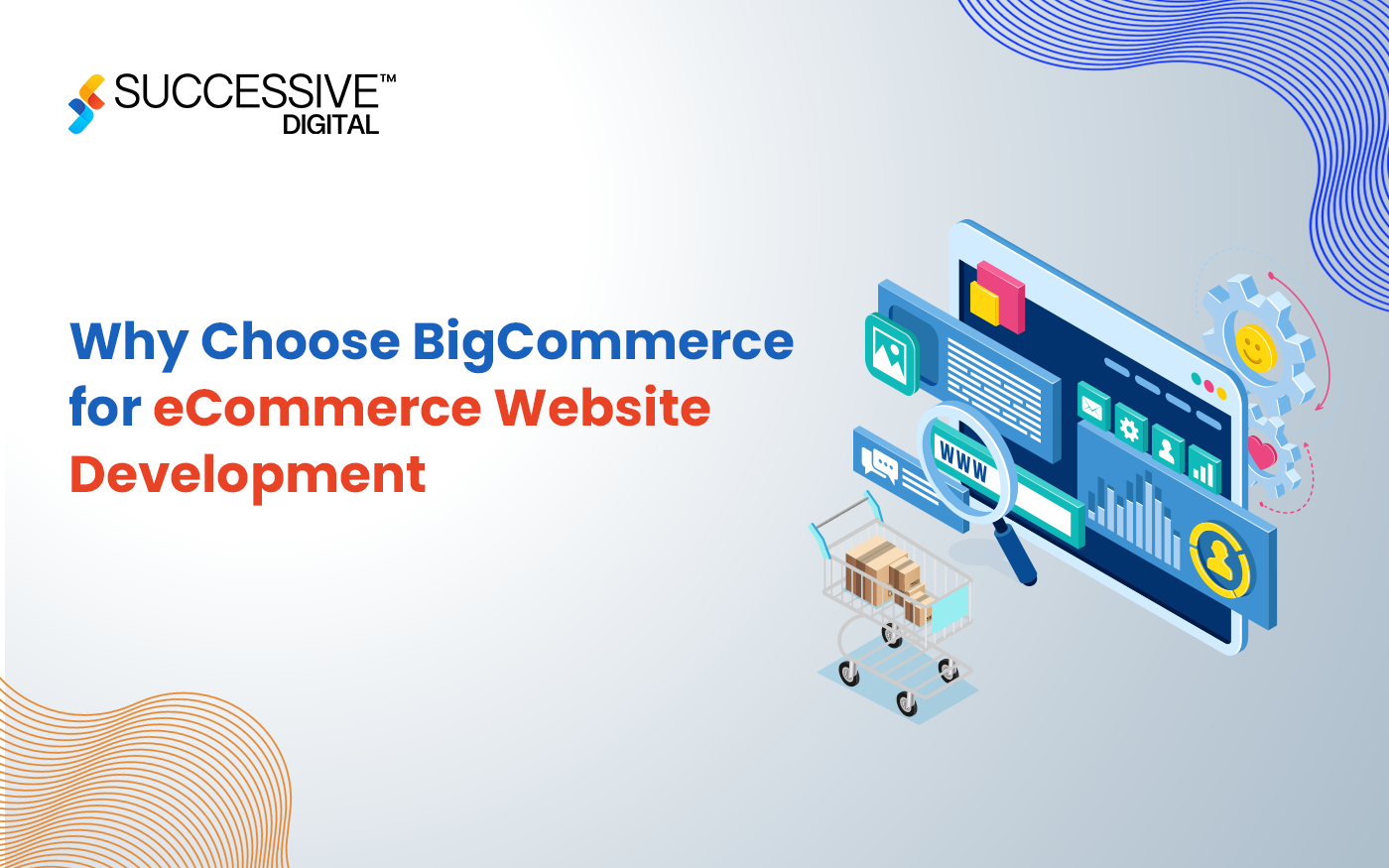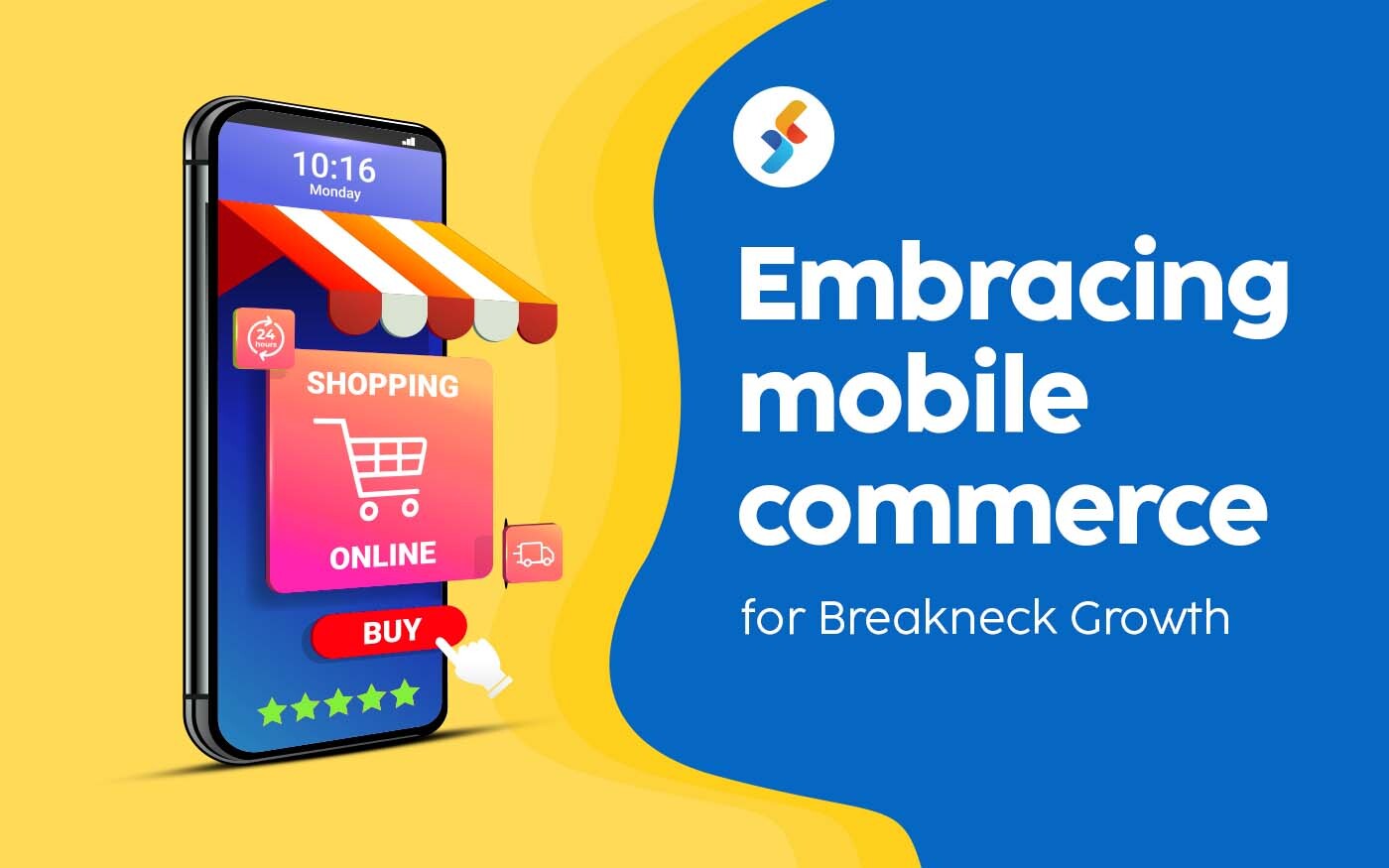If you are creating a marketplace platform, you have two sets of users to consider: buyers and sellers. Your go-to-market (GTM) strategy — as well as your long-term business goals— have to address and align on the needs of both.
While this makes setting up a marketplace more complex than setting up a single vendor e-commerce storefront, it pays off in the long run. Since marketplaces are inherently more sustainable than general e-commerce stores, with the right strategy, you can deliver benefits symbiotically to both buyers and sellers, as well as earn a good margin for yourself.
How to create the best GTM strategy for your marketplace
A number of our retail and collaborative commerce clients have faced this need before, and we’ve helped guide their approach with the right technology. Here’s a step-wise framework for creating your GTM strategy:

Step 1. Define your market and profile your ideal users
Before you get started, you should closely consider who it is you want to build your marketplace for.
Research your target market
While everyone understands the importance of effective market research, few businesses put it into effect. But the research you do at the early stages will determine your likelihood of success later on.
To get started creating your GTM strategy, use published market research and surveys to better understand your target market, its size, growth potential, and any major trends. Validate whether there is really a need for a marketplace platform by speaking to real sellers and buyers in that industry. Some questions to consider:
- Which industries do you want to operate in?
- What kind of problems do sellers and buyers in this industry face?
- Could a marketplace platform help solve any major problems for both sellers and buyers?
- Would sellers and/or buyers be willing to pay to use such a marketplace?
Choose your niche carefully
Defining a niche for your marketplace allows you to get more specific about what your brand is offering. By focusing your efforts on a limited number of categories, you can easily gain a competitive edge. A well-defined niche will help you strongly appeal to a small segment of buyers who can then go on to become loyal customers.
You can define your niche on the basis of a few factors such as:
- Demographic data (such as age, gender, marital status, income, etc)
- Values and beliefs (e.g. sustainability, fair trade, etc)
- Lifestyle (e.g. remote workers, frequent travelers, etc)
- Hobbies and interests (e.g. gamers, avid readers, etc)
- Price (ranging from luxury to budget)
- Production quality (ranging from highly engineered products to value-for-money options)
- Location (e.g. a particular country, city, locality, etc)
You can explore different industry trends to spot ideas, understand the popularity of each of your ideas through Google searches and other means, and test them with small batches of users. This will help you arrive at an idea that really speaks to your target audience’s needs.
It’s also important to choose a market that’s an optimal size to allow you to dominate and grow. If you are targeting a very niche market, you may find there isn’t really a need for a marketplace if all the major sellers are already closely connected with buyers. On the other hand, if you target a market that’s too large, you may find yourself competing with well-established marketplaces that have access to a lot of resources.
Read about 7 Ways to Encourage Impulse Buys on Your E-Commerce Platform
Who does your marketplace benefit the most?
There may be many people who can use your marketplace. But it’s not practical to target all of them. Start by understanding the different types of sellers and buyers you can target, where they reside, and the size of each group.
Out of your addressable market, which segment of users can you offer the most value to? These will be the prospects you can close fastest.

Focus on them. Learn who they are, down to the smallest details, and what problems they face. Learn about their particular behaviors and characteristics. What does their typical journey look like? How can your marketplace help them?
Once you have the answers to these questions, you can move on to the next step.
Step 2. Identify your unique positioning
Now that you have an understanding of the market, it’s time to get specific about the unique value you can offer.
What problem are you solving?
To succeed, it’s important that you clearly understand why you are building your marketplace.
There may be a problem you’ve encountered that others in your industry also find to be frustrating. Maybe there isn’t a good solution to this problem available for your industry, and your marketplace can solve the problem — for both buyers and sellers.
You could be looking to offer competitive pricing or convenience to your buyers, or improve access in an industry that’s populated by many small-sized sellers. It may be that you offer a wide range of third-party integrations that can help sellers with different business functions, or you might offer affordability to buyers.
Hone in on what you’d like to achieve with your marketplace and validate your idea using your initial research.
Use feedback from real buyers and sellers within your target market to improve your proposition and discover what really resonates with them. You may find the reality is quite different and you need to adjust your idea to be profitable and to benefit the largest number of users.
Know your competition
Understand the existing competitive landscape, and then consider what sets your marketplace apart from other platforms. Are there already existing marketplaces in your chosen niche? If yes, is the market large enough for multiple players? If other players have been forced to shut shop, what lessons can you learn from them?
You should also have a good understanding of the direction the market is heading in so that you can be certain that you can adapt your unique value proposition (UVP) to serve an evolving market.
The UVP you identify at this stage will inform your marketing strategy further down the road.
Read about The 7 Secrets of E-commerce Giants – And What Can You Learn From Them?
Step 3. Select your pricing model
Each marketplace is different, and choosing the right business model for your marketplace requires a judicious mix of industry experience and inspired thinking.
These are some of the monetizing strategies for marketplaces that you can consider:

Sign-up fees: In this model, sellers are charged a sign-up fee when they register. This model doesn’t scale very well, but it is a good way to cultivate exclusivity around marketplaces with high value or unique offerings.
Listing fee: Here, the seller is charged a fee for every new listing they publish. This model scales well and can be implemented once the marketplace has reached a substantial size, making it important for sellers to list their products on it.
Commission: The marketplace charges the seller or buyer (or both) a percentage or fixed fee for every transaction made.
This is probably the most attractive model of all and is used by many large platforms. It’s a good idea to begin with this model and consider other strategies only if it fails.
Lead-gen based: Sellers pay a fee for each new lead acquired. A good use case for this is marketplaces listing service providers. Buyers can browse listings for free but need to pay a fee to get the contact details of a particular service provider. Sellers can be charged higher fees for better exposure.
Subscription: Sellers pay a monthly or annual fee to use the marketplace. This model is useful for generating recurring revenue. For heavy users of any platform, paying a subscription fee is often cheaper than many individual purchases.
Advertising: When a marketplace has grown to a substantial size, advertising can become a good source of revenue. The more users it has, the more third-party advertisers can be charged to place their ads on the platform. Sellers can also purchase ad listings to gain increased visibility.
Value-added services: Besides connecting buyers and sellers, marketplaces can offer complementary paid services like insurance, fulfillment, etc. Marketplace owners have thousands of data points worth of information about their users. They can use this to inform decisions about potential new offerings and build these over time.
By creating an ecosystem of products and services that extends comprehensively across the entire value chain, marketplaces can set themselves apart from the competition and keep users engaged.
More complex monetizing strategies for marketplaces are emerging that employ a mix of all of the above.
A good rule of thumb is to listen to the community of buyers and sellers and take cues from them. By doing this, marketplace owners can discover models that allow sellers to make the most of the marketplace’s capabilities.
Step 4. Build an appropriate marketing strategy
Now, you can start to create a holistic plan to draw users to your marketplace platform.
Generate your initial supply and demand
Start by attracting sellers to your marketplace. Engage them through online and offline channels and show them the value your marketplace can create. Join communities and visit events that matter to them and start conversations. Once you understand their challenges well, you can propose your marketplace as a viable solution.
At the same time, work on generating demand by promoting your marketplace among buyers. Partner with social media influencers, offering discounts to those who can attract more buyers. Run paid ad campaigns using popular platforms such as Facebook and Google.
Have a compelling incentive in mind to offer your first buyers (such as free credit or services) to draw them to your brand new marketplace platform. You may have to try different tactics to see what clicks with your audience.
Promote, promote, promote
You may find it most effective to not charge your first sellers a fee at all. Invite them to use the platform in exchange for their reviews on sites like Clutch. Buyers can be requested to share reviews on sites like CrowdReviews. Such social proof can help you attract more buyers and sellers to your platform.

Early marketing initiatives should include doing things that are effort-intensive and not necessarily scalable, such as face-to-face meetings with sellers, and so on. This can help to create a small but dedicated group of users who then go on to bring others.
Also, invite your sellers to bring their customers to your marketplace. To tip the scales, you can add an incentive for sellers like a free service or access to valuable premium features on your platform.
Create a long-term plan
In the long term, content marketing and SEO can help you rank higher in search and drive more traffic to your platform. Try approaches using different content formats such as articles, blog posts, videos, and infographics. Email marketing can also be a good way to keep users engaged. Measure your results constantly to see what works best.
Set goals with milestones that can help you track how well your marketing efforts are working. Consider your long-term goals as well, visualizing what you want to see happen in six months or a year, and make a plan to achieve them.
Continually refine your GTM strategy
The four steps above should get you well on your way to creating the best GTM strategy for your marketplace.
But a go-to-market strategy isn’t something that can be created and then left unchanged forever. It has to function as a living document that you continuously clarify and distill further as you understand more and more variables impacting your particular niche.
Rapidly iterating and improving your approach can help you arrive at the most effective strategy for your marketplace.
Read SaaS vs. Custom eCommerce Platforms: What’s Best for Startups?












